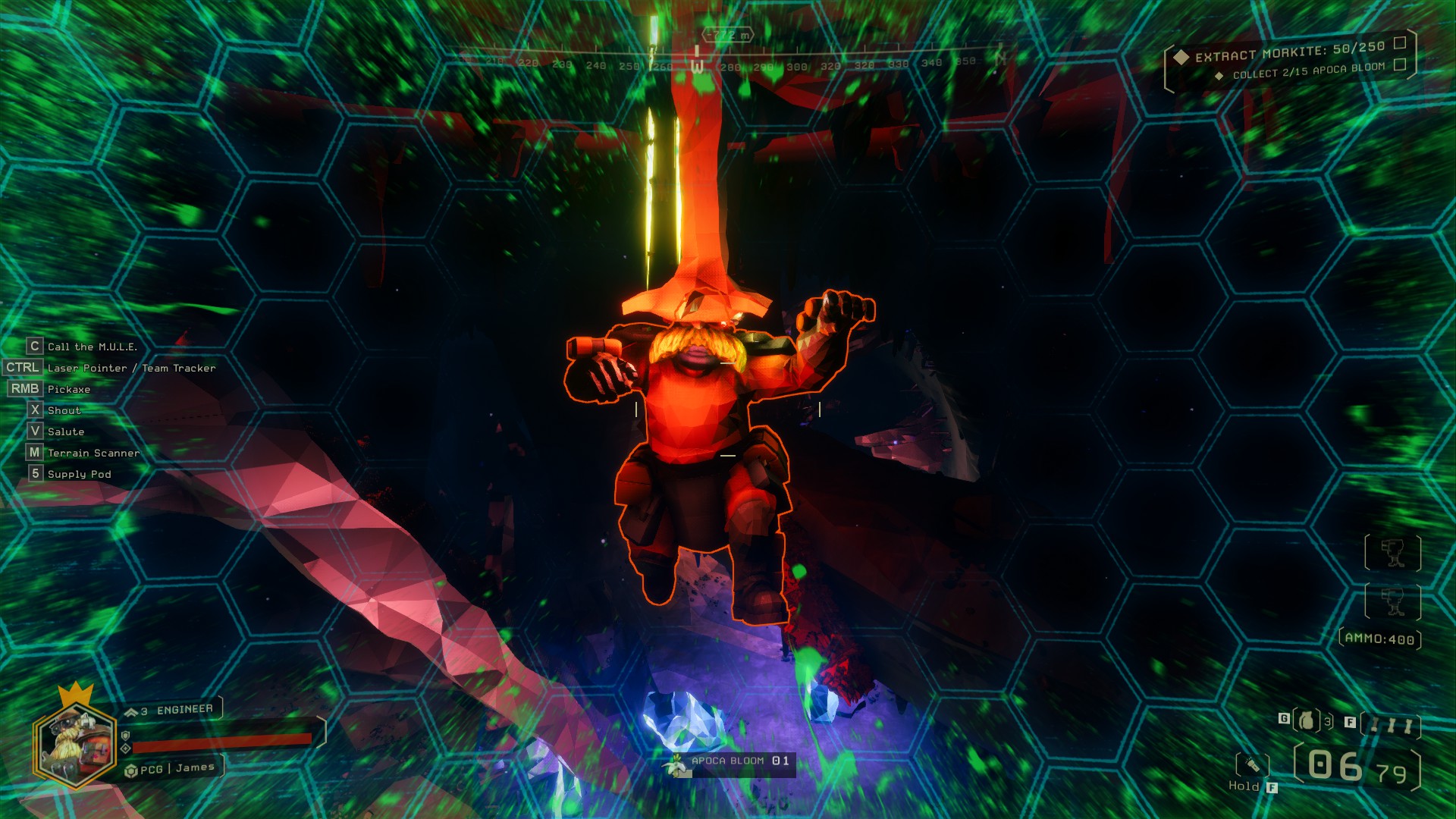Deep Rock Galactic's Left 4 Dead-like mining adventures make it the ideal Early Access game
DRG now has a rock solid foundation for playful iteration, even if it's not infinitely fun quite yet.
Deep Rock Galactic, the 4-player co-op mining romp through procedurally assembled cave systems, is releasing into Early Access on February 28, and though it hasn't changed much since Evan and TJ last played it, it's going to be the perfect game to grow in Steam's open-development petri dish.
A quick primer for the uninitiated: You play as one of four space dwarf classes, each with their own weapon types and navigation ability, from shooting ziplines to sprouting mushroom platforms, and spelunk like it's your job (it is), digging for a host of minerals throughout several biomes. All this, while reducing the occasional swarm of space bugs to goo and making sure not to disturb too much of the local flora and tectonic hazards. Just about everything wants you dead, and rightfully so—I mean, what are you if not a meaty, dwarf-shaped fracking injection?
When I talked to the developers at Ghost Ship Studios, they explained how shipping the Early Access build was all about getting the primary progression loop of mining, leveling your character, and upgrading gear functional. And those progression systems are pretty light touch, the upgrades to gear and weapons moving in a straight line of efficiency rather than one of diversifying behaviors—flares last longer, the pick does more damage, shotguns can hold extra rounds—while the aesthetic upgrades are made up of beards and simple color palette swaps. With a working foundation in place, the devs at Ghost Ship will spend the next several months of Early Access time increasing the stupid ways in which you can die, bless 'em.
After a few hours with the current build, I've already fallen victim to long falls, inhalation of deadly gas via a bug corpse, and incineration via a boisterous spout of magma. I've been blasted into dwarfish pieces from an explosive chain reaction of distended mushrooms and had my head sucked off by a spot-on impression of Half-Life's ceiling-dwelling barnacles. Lucky me, I haven't killed or been killed by a teammate yet, despite the always-on friendly fire. There are a lot of ways to die, most of which are represented by the local flora and fauna of each biome, those methods multiplied by the mistakes you're guaranteed to make when the systems and variables collide.

The procedural arrangement of these hazards, along with the disorienting, dark assembly of cave systems guarantee the first few hours of digging are full of tense experimentation and dumb accidents. Porous magma-filled bulbs that explode if irritated are often close enough to one another to guarantee a chain explosion, which, as I found out, can be used to dissolve an incoming swarm… or friend, if you're not careful. Environmental hazards are a danger to both you and the enemy, and the arc from discovery and death to using them against your foe is satisfying, though less novel with each use. Sustaining that impromptu resourcefulness should be easier once more deadly space plants are added, or whatever Ghost Ship comes up with.
In another biome, tall, narrow plants act as an elevator, their massive leaves making for a convenient mode of transit if shot in the right spot. I used one to get out of the thick of it as the swarm overwhelmed my empty turrets. A grenade from above finished the job. It's procedural variables like these that make a good case for DRG's repetitive nature and Early Access upbringing. With so many dangerous plants, indigenous monsters, and geological phenomena in the same dwarf-miner-fantasy pot, and more on the way as the updates roll in over the year, the opportunities for serendipitous, blessed Emergent Gameplay™ increases.
I'm a big fan of games that fill themselves with hands-off systems and let their big bag of dice spill over, the faith left with the players and basic means of interaction to make the best of it. If all your target minerals are on the ceiling of a massive, cavernous room where the floor is a minefield of magma-spewing bulbs, the walls are coated with poison-belching monsters, and the leftover space is filling with tanky space bugs—well, tough luck. Living to tell the tale is the reward. Failing might sting, but still makes for a story.
The biggest gaming news, reviews and hardware deals
Keep up to date with the most important stories and the best deals, as picked by the PC Gamer team.
Even so, I'm growing tired of what's there. Risking your tail and stretching your ammo reserves thin to stick around for a bit more mining is a thrilling risk-reward tradeoff, and managing light as a resource as you descend further and further is fun, sure, but you'll have seen all the swarm enemies after your first big battle. And while the biomes feature different characteristics and unique hazards, they all feel far to similar right now. Waiting on DRG to inflate before buying in wouldn't hurt, though it leaves a better first impression than most of the Left 4 Dead-like games I've played. The environments are just lacking the diversity and unpredictability to keep the same caves surprising for the long haul. I really hope Ghost Ship gets inventive and cruel.
Besides diversifying the horrible ways in which you'll die, the gear upgrades aren't very interesting and the cosmetics are too simple to feel expressive, which dulls my desire to replay missions just to grind out specific minerals. There's a lot to room to improve, but that's OK. With each batch of updates to the biomes my hope is that the journey, not the expensive-bushy-beard-cosmetic destination, becomes enough. (That's no excuse to skimp on the beard selection, though.)
James is stuck in an endless loop, playing the Dark Souls games on repeat until Elden Ring and Silksong set him free. He's a truffle pig for indie horror and weird FPS games too, seeking out games that actively hurt to play. Otherwise he's wandering Austin, identifying mushrooms and doodling grackles.


